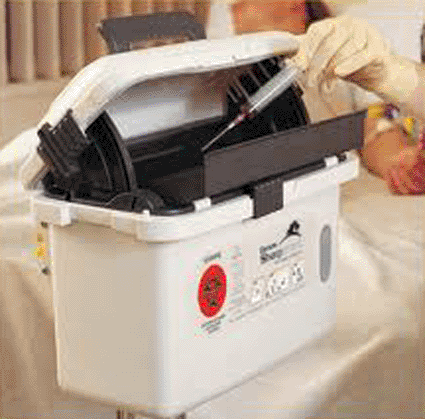Needlestick Injuries Dramatically Reduced by Disposal Device
By LabMedica International staff writers
Posted on 15 Dec 2010
A safety enhanced disposal device could prevent more than 19,000 accidental needlesticks and other "sharps" injuries to healthcare workers.Posted on 15 Dec 2010
Healthcare workers stuck by sharps such as needles, scalpels, scissors and lancets are at risk of being infected by one of more than 60 blood borne diseases, the most worrisome being Human Immunodeficiency Virus (HIV) and Hepatitis B and C.

Image: Daniels’ Sharpsmart Reusable Container for sharps (photo courtesy Daniels International).
In a before and after intervention study from 2006 to 2008, scientists examined the impact of conversion to a sharps container with enhanced engineering on sharps injuries (SI) categories in 14 hospitals (study group). The container's safety features included large horizontal aperture, sensitive counterbalanced door, large atrium, and passive overfill prevention. Study group results were also compared with a control cohort of 14 contemporaneous size-matched, hospitals (control group).
The study found the use of the sharps disposal device reduced by 81% the number of container-associated sharps injuries that occurred in a group of 14 hospitals over one year. The number of sharps injuries were four-fold fewer in those hospitals compared to 14 hospitals that used a different sharps disposal device. The device was also associated with a significant 30% reduction in after-procedure and 57% decrease in disposal-related injuries in the study group.
The reusable device is the Daniels Sharpsmart, (Daniels International, Chicago, IL, USA), where the enhanced aperture design can significantly reduce container-associated sharps injuries. Other factors contributing to reduced injuries may include one-hand deposit, safe closure, hand restriction, and preassembly. Sharps injuries can occur in a variety of ways, including during disposal of the sharp in a container made for that purpose. When using standard disposal containers, the healthcare worker can be stuck by the needle as it is being deposited in the container or by another needle that is protruding from the opening, because the container is too full, or because previous needles were not correctly contained.
Terry Grimmond, F.A.S.M., a microbiologist and the lead author of the study said, "Other than a few modest improvements, sharps disposal containers have not changed much in several years. This study suggests that design improvements can significantly reduce the effects of risky human behavior.” The study was published in December 2010, in the American Journal of Infection Control.
Related Links:
Daniels International







 assay.jpg)






